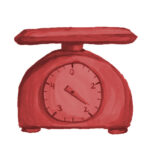 Component Exploration: Reflecting on Rose’s Art
Component Exploration: Reflecting on Rose’s Art
It Too, Will Change by Rose
Rose (they/them) – Artist’s Statement and Reflections
I am a digital media artist, multiply disabled. I am Indo-Gyuanese and English descent. [An] interesting thing I’ve been doing recently is getting into film poetry, which is something I’ve wanted to do for a long time. I’ve wanted to develop a kind of film poetry practice… but I never really had the space to do it until pandemic times kind of shifted a lot of things around for me. For work, primarily, I do illustration, graphic design and video editing. Pre-pandemic, I was a vendor in the local Toronto area for five years and I [sold] my original art products like prints and zines on growing up in the suburbs, stuff around being autistic, mixed race identity, things like that. I did that for five years and then the pandemic happened. And then I was, like, what am I doing? Lots and lots of shifts have been happening in my life…
For this one I think I knew it was going to be blue from the get go, I don’t know why. I also have a monarch butterfly tattoo right here. I think it’s a big symbol of change, for me, and I think it’s really cool just like a caterpillar literally melting and becoming a new thing. They [butterflies] were always really cool and fascinating. I think the idea of a chrysalis is really cool. Just like thinking about the body that way and like regeneration is really cool. Oh yeah, also I put lots of hearts, because when I was a kid I used to exclusively draw butterfly antennas with the hearts. I was like: “I’m going to do this as an ode to myself.” So that’s why I did that. I’m like: “Does that hurt the caterpillar to make the chrysalis?” That sounds painful to me. I think in healing work, healing can be very painful as well, and coming to name emotions especially. I am thinking back to my younger self learning how to name emotions and the kind of pain that comes with recognizing that I haven’t always had access to this language as a resource.
[This] reminds me of the beginning of this therapy relationship with my old therapist – a new kind of really revitalized relationship… I was talking about why during the pandemic I’ve been grappling with a lot of emotional pain in relation to certain things, and then I was just just like: “I’ve never had such intense emotional pain for a prolonged period of time as what I do right now.” [My therapist] reflected to me: “Where I am right now in my life I have so much access to different resources that I didn’t before. Do you think you now have access to space to actually feel the depth of your feelings and go there with yourself?” I was just like “Oh yes. Yes.” And that was big for me to hear like six months ago, or something. I think it really goes back to that gratitude and transformation and how I think they’re all kind of rooted in each other.
“I want to find comfort in you and I want to find comfort in our future” is at the bottom. Those words are supporting her, encompassing. I like that a lot, now that I’m looking at it. I think a type of relationality rooted in gratitude and being able to acknowledge that for yourself is a huge takeaway in my own healing and I would love for students to be able to see that and carry that with them. I think this piece is really about healing and transformation and community. I would just like for people to be able to see that kind of relationality [that] I wanted this [art piece] to embody.
I think one: that healing can feel good. I think gratitude, naming gratitude for me here and seeing that was pretty big because it’s very true and that’s really where it came from for me. Really, that piece on regeneration and transformation and how that can happen… It can take time and I think there’s a thing to be said about healing can take time and it can also take less time than we think it can. Healing can be painful, but it can also be less painful than you think it would be… I think would be nice for someone to know as they enter a more intentional healing practice with themselves. I think being able to reflect on my past selves and have that gratitude for myself, there’s a lot of surprise there too in really embodying gratitude. It’s a nice surprise, not a dysregulating surprise. It’s kind of like a grounded “Oh, this is nice. I’m surprised that it feels good.” And I think that that counts for a lot.
I didn’t really plan it out, I just had a faint idea, and then I just did a thing. That feels really good for me. To be intentional about being less intentional. I think that’s pretty powerful and expansive in a way. Just to let myself do a thing and carve out that time and just take it up. Also my handwriting. I have been putting more of my handwriting into my pieces, which is a really vulnerable practice for me.



 Français
Français